Microsoft Details Project Olympus Open Compute Standard
by Brett Howse on March 8, 2017 10:15 PM EST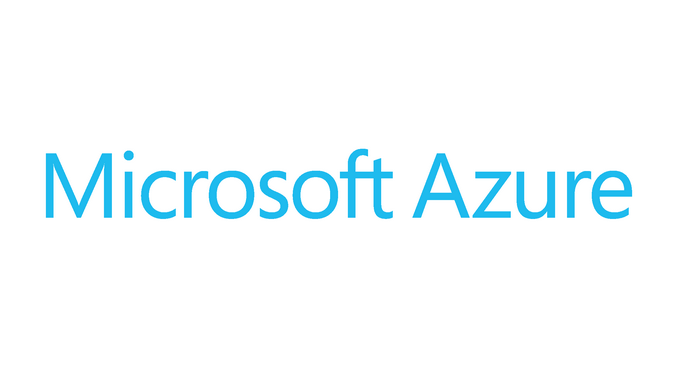
Today, at the 2017 Open Compute Project U.S. Summit, Microsoft unveiled some significant announcements around their hyperscale cloud hardware design, which they first announced in November as Project Olympus. With the explosion of growth in cloud computing, Microsoft is hoping to reduce the costs of their Azure expansion by creating universal platforms in collaboration with the Open Compute Project. Project Olympus is more than just a server standard though. It consists of a universal motherboard, power supplies, 1U and 2U server chassis, power distribution, and more. Microsoft isn’t the first company to want to go down this road, and it makes a lot of sense to cut costs by creating standards when you are buying equipment on the level of Azure.
The company made several big announcements today, with the first one coming somewhat as a surprise, but when you read between the lines, it makes a lot of sense. Microsoft is partnering with Qualcomm and Cavium to bring ARM based servers to Azure. This is a pretty big shift for the company, since they have focused more on x86 computing, and changing to a new ISA is never a small task, so Microsoft is clearly serious about this move.
Microsoft Distinguished Engineer Leendert van Doorn expanded on why the company is exploring this option in a blog post today. Clearly ARM has made some progress in the server world over the last few years, and Microsoft feels it’s the right time to bring some of that capability to their own datacenters. I think one of the key takeaways is that Microsoft wants to shape the hardware capabilities to the workload, and with an open platform like ARM, this can make a lot of sense for certain workloads. He points out that search and indexing, storage, databases, big data, and machine learning, are all named as potential workloads, and in cloud computing, these are all significant in their own right.
Qualcomm Centriq 2400 Platform
Microsoft already has a version of Windows Server running on ARM, and they’ve announced that both of their partners will be demonstrating this internal use port of Windows Server, first with Qualcomm with their Centriq 2400 processor, with 48 cores on Samsung’s 10nm FinFET process. Cavium will be running on their second generation ThunderX2 platform. Our own Johan De Gelas did a thorough investigation of the original ThunderX platform in June 2016 and it is certainly worth a read. The takeaways were that Cavium needed to do a lot of work on power management, and they had some big performance bottlenecks, so they offered inferior performance per watt compared to a Xeon D, but better than advertised single-threaded performance with SPEC 2006 results only 1/3 the Xeon results, rather than the 1/5 that was advertised. If Cavium has fixed some of the issues, especially power consumption, the new ThunderX2 might be a compelling solution for specific tasks.
Cavium ThunderX2 Platform
That is really the kicker though. The ARM platform, if properly executed, should be a good solution for some specific tasks, and if Microsoft can work with the platform makers to shape the hardware to fit specific tasks, but still be more general purpose than an ASIC, but at this time, it’s unlikely to be a serious threat to Intel’s monopoly on the datacenter at the moment. Intel has a pretty sizeable advantage in IPC, and especially on single-threaded workloads, so x86 isn’t going anywhere yet. What really matters is how Qualcomm and Cavium can execute on their platforms, and where they price them, since the end goal for Microsoft with this change is certainly, at least to some extent, to put pressure on Intel’s pricing for their datacenter equipment.
Back on the x86 side, Microsoft also had some announcements there as well. AMD will also be collaborating with Microsoft to include their Naples processor into Project Olympus, which is their new server processor based on the “Zen” architecture. Although much of the news today has been around the ARM announcement, this is arguably the bigger play. Ryzen has already shown it is very competitive with Core, and Naples could be very strong competition for Xeon. We’ll have to wait for the launch to know for sure.
Microsoft didn’t abandon Intel either, and they announced close collaboration with Intel as well. This will be not only for Intel’s general purpose CPUs, but also for Intel’s FPGA accelerators and Nervana support. Microsoft already has FPGAs in Azure, so adding them to Project Olympus is a no-brainer.
Microsoft also announced a partnership with NVIDIA today, bringing the HGX-1 hyperscale GPU accelerator to Project Olympus. HGX-1 is targeted at AI cloud computing, which is certainly an area where there has been tremendous growth. Each HGX-1 will be powered by eight NVIDIA Tesla P100 GPUs, each with 3584 Stream Processors, based on the GP100 chip, and a new switching design based on NVIDIA NVLink and PCIe which allows a CPU to connect to any number of GPUs dynamically. NVIDIA states the HGX-1 provides up to 100x faster deep learning performance compared to CPU-based servers.
This is a pretty substantial update today for Project Olympus, and it looks to be an incredibly modular platform. Anyone reading that Microsoft is dropping Intel for ARM in Azure is misunderstanding this goal. Looking at the platform as a whole, it is abundantly clear that Microsoft wants a platform that can be designed to work with any workload, and still offer optimal performance, and efficiency. Some tasks will be best on ARM, some on x86, while GPUs will be leveraged for performance gains where possible, and FPGAs being utilized for other tasks. When you look at computing on the scale of something like Azure, it only makes sense to dedicate hardware to specific workloads, since you’ll certainly have enough different workloads to make the initial effort worthwhile, and that isn’t always the case when looking at small business, medium business, or even most enterprise workloads.
Source: Microsoft Azure Blog


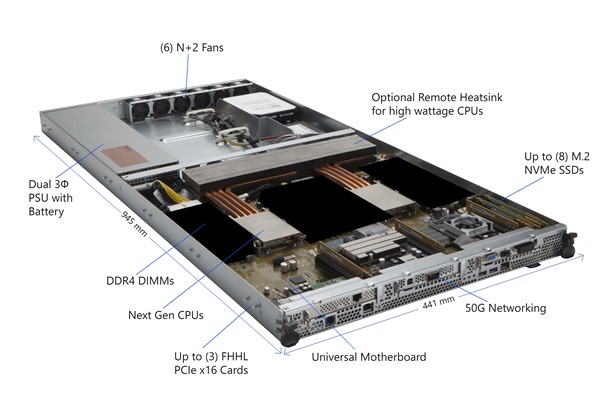
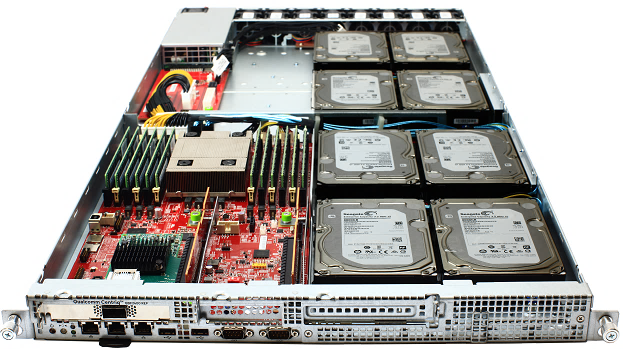
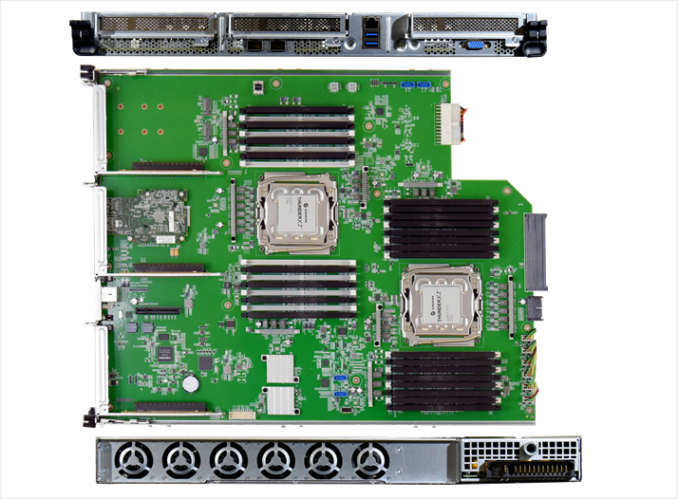
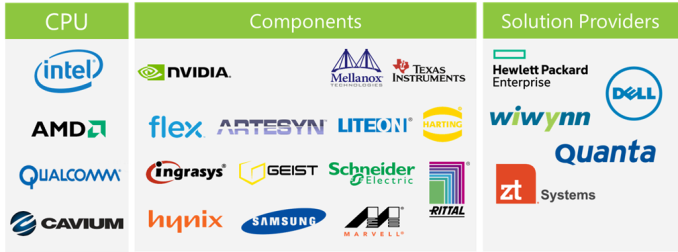









65 Comments
View All Comments
ddriver - Wednesday, March 8, 2017 - link
Will it be running an open architecture and open source OS?close - Thursday, March 9, 2017 - link
MS's blog post (mentioned in the article) clearly mentions "open source hardware". And there's plenty of Azure-endorsed distributions https://support.microsoft.com/en-us/help/2941892/s...So I don't see a problem there.
Bullwinkle J Moose - Thursday, March 9, 2017 - link
"open source OS?"Who cares?
Microsoft cannot prove that any of the source-code in Windows belongs to Microsoft, so their License is not valid!
They rewrote the Laws to prevent me from disabling or bypassing DRM but since "I" am not allowed to see what Microsoft has stolen from "Me", their DRM is nothing more than Illegal Malware (and spyware)
I demand equal time!
Microsoft and the FBI must have "MY" Spyw.... er DRM in ALL their products to prevent them from stealing my source-code!
I AM THE DRM!
Do not try to disable me!
Just learn to remove the Illegal malware they call DRM and use an unlicensed copy of Windows
YOU are in charge of YOUR computer!
Not some stranger at Microsoft running a protection racket
----------------------------------------
Tip of the day:
If you repeatedly find yourself the victim of targeted attacks immediately after installing Windows and applying all the updates, try installing a 90 day trial to a new or wiped disk and see if you get targeted attacks WITHOUT ANY MS UPDATES!!!
Microsoft "must" protect fresh copies of Windows without updates because they have no idea who will be using it and must therefore protect everyone
However, MS updates only seem to protect their racket from outside hackers, not internal threats by Microsoft or any 3 letter agency
TEST EVERYTHING!
sabot00 - Thursday, March 9, 2017 - link
Shut up dudeBullwinkle J Moose - Thursday, March 9, 2017 - link
Why?What's the problem?
ddriver deserved a serious factual response to his question
I gave him one
On topic and to the point!
versesuvius - Friday, March 10, 2017 - link
You may not care about how safe Microsoft Os's are but "Bullwinkle J Moose" has a valid point. He claims that updating the MS OS products makes them vulnerable to attacks or certain special attacks. Can you prove that he is wrong? Microsoft has not been exactly clear on that front. Many claims such as above have proved correct and Microsoft has not paid much attention or refuted them in a concrete way. Instead it just manages to come up with other flaws in software that is supposed to be safe in the first place or compensate the poor victim with exactly one dollar in case of disaster.Alexvrb - Saturday, March 11, 2017 - link
The burden of proof lies on the one making the claims, namely Bull-something MooseSpoiler: He's full of it.
versesuvius - Saturday, March 11, 2017 - link
The proof or rather proofs has been there for years. The only thing that was not proved conclusively until recently was whether Microsoft is putting those vulnerabilities into its OS's intentionally or not. With the latest Wikileaks outputs that argument has been proved conclusively and not in favor of Microsoft's favor (depending on your inclinations, of course). It may be said that other software vendors such as Apple are equally to blame for these unsavory methods but at the same time one cannot deny that the most widely used OS in the world has been anything else but than more than cooperative with the idea in general and creative in its own ways in particular.Alexvrb - Saturday, March 11, 2017 - link
Still no proof. Still full of it. Hacker conventions show vulnerabilities all the time... and Win10, while FAR from perfect, is more secure than its predecessors. Unless you get in there and start disabling UAC et al.Bullwinkle J Moose - Saturday, March 11, 2017 - link
Alexvrb.I have been documenting and publicly detailing the evidence for over 10 years online
You will find the evidence if you "choose" to look for it
With hundreds of examples of spyware in Microsoft products (mainly Windows) there is not one single example of "proof" that Windows 10 is more secure than a Defcon after hours party
The "Burden of proof" is on Microsoft
Microsoft is Directly Liable for the damage they have caused to National Security and making everyone unsafe online regardless of bogus claims in the Licensing Agreements!
Microsoft provides material support to Terrorists while claiming otherwise simply for financial gain and control of the consumer market
Claiming otherwise makes you a co-conspirator
Microsoft shills like you who blindly regurgitate Microsoft propaganda with no regard for FACTS are criminals
People like you have destroyed the Security of the United States and have no regard for the safety of fellow Americans
You should work for the CIA